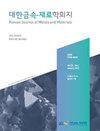Electronic Transport Properties of Bi<sub>2</sub>Te<sub>2.7</sub>Se<sub>0.3</sub> Fabricated by Hot Extrusion
IF 1.4
4区 材料科学
Q4 MATERIALS SCIENCE, MULTIDISCIPLINARY
引用次数: 0
Abstract
Herein we report the optimized processing conditions of hot extrusion for fabricating an n-type Bi2Te2.7Se0.3 thermoelectric compound, with high electronic transport properties as well as improved mechanical reliability. We fabricated a Bi2Te2.7Se0.3 extrudate that was 3.8 mm in diameter and 700 mm in length by controlling the processing parameters of temperature and pressure. A 3-point bending strength of over 70 MPa, which is 7 times higher that of the commercial zone melting ingot, was obtained in the samples prepared at 460 oC temperature under 6–6.5 MPa pressure. The samples benefitted from the formation of a highly-dense microstructure (relative density > 98%). It is noted that the electronic transport properties (electrical conductivity and Seebeck coefficient) could be manipulated by controlling the applied pressure of hot extrusion at 460 oC, mainly due to the change in the characteristics of the 00l crystal orientation, which originated from grain rotation and rearrangement. Power factor values of ~2.9 mW/mK2 at 300 K and ~2.95 mW/mK2 at 320 K, similar to those of sintered bulks, were obtained in the hot extrudate fabricated under processing parameters of 460 oC and 6 MPa. Moreover, a high power factor value of 2.25 mW/mK2 was observed even at the high temperature of 480 K, which is 70% higher than that of Bi2Te2.7Se0.3 bulk fabricated by hot pressing.Bi<sub>2</sub> te>2.7</sub>Se<sub>0.3</sub>热挤压成形
在此,我们报告了优化的热挤压加工工艺条件,用于制造<i>n</i> 2</sub>Te<sub>2.7</sub> se>0.3</sub>热电化合物,具有高电子输运性能和提高的机械可靠性。我们制造了一个Bi<sub>2</sub>Te<sub>2.7</sub> se>0.3</sub>通过控制温度和压力等工艺参数,可挤出直径为3.8 mm、长度为700 mm的物料。在6-6.5 MPa压力下,在460 <sup> 0 </sup>C温度下制备的试样,获得了超过70 MPa的3点抗弯强度,是商业区熔炼钢锭的7倍。样品受益于高密度微观结构的形成(相对密度>98%)。注意到,通过控制热挤压施加压力在460 <sup> 0< /sup>C,可以控制电子输运性质(电导率和塞贝克系数),这主要是由于00<i>l</i>晶体取向,源于晶粒的旋转和重排。功率因数值为~2.9 mW/mK<sup>2</sup>在300 K和~2.95 mW/mK<sup>2</sup>在温度为460℃/℃,温度为6 MPa的条件下,制备的热挤压物在320 K时获得了与烧结块体相似的形貌。此外,2.25 mW/mK<的高功率因数值sup>2</sup>比Bi<sub>2</sub>Te<sub>2.7</sub>Se<sub>0.3</sub>热压成型的体块。
本文章由计算机程序翻译,如有差异,请以英文原文为准。
求助全文
约1分钟内获得全文
求助全文
来源期刊

Korean Journal of Metals and Materials
MATERIALS SCIENCE, MULTIDISCIPLINARY-METALLURGY & METALLURGICAL ENGINEERING
CiteScore
1.80
自引率
58.30%
发文量
100
审稿时长
4-8 weeks
期刊介绍:
The Korean Journal of Metals and Materials is a representative Korean-language journal of the Korean Institute of Metals and Materials (KIM); it publishes domestic and foreign academic papers related to metals and materials, in abroad range of fields from metals and materials to nano-materials, biomaterials, functional materials, energy materials, and new materials, and its official ISO designation is Korean J. Met. Mater.
 求助内容:
求助内容: 应助结果提醒方式:
应助结果提醒方式:


